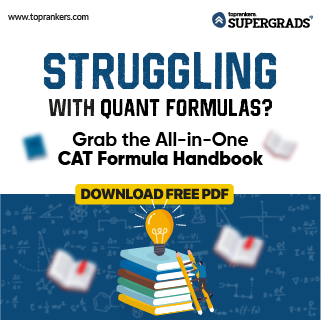CAT Syllabus 2026: Section-wise Topics, Weightage & PDF Download
December 15, 2025
Overview: Understanding the CAT 2026 Syllabus is the first step in making the study plan for the final day. Here, let’s scroll down and learn the section-wise CAT syllabus PDF and weightage for the CAT exam!
- The CAT 2025 exam (for the 2026–28 MBA intake) was conducted on November 30, 2025, across 170 cities in the country.
According to the exam pattern, the CAT exam syllabus 2026 will be divided into three main sections:
-
Section 1: Verbal Ability and Reading Comprehension (VARC)
Section 2: Data Interpretation and Logical Reasoning (DILR)
Section 3: Quantitative Aptitude (QA) - Official CAT website: For notification/admit card/response sheet/answer key updates, refer to the official portal: iimcat.ac.in. (IIMs do not publish an official topic-wise syllabus PDF.).
Read the CAT exam pattern and syllabus here and download the CAT syllabus for MBA 2026 PDF below!
Read More | CAT Admission Process 2026
What is CAT Syllabus 2026 for MBA Entrance Exam?
The MBA CAT 2026 syllabus covers quantitative ability, data interpretation and logical reasoning, verbal ability and reading comprehension. It assesses mathematics, logical thinking, reading, and language abilities. The test consists of 68 questions in 120 minutes.
To do well on this competitive admission exam, you must be well-prepared and manage your time. You can download the CAT Syllabus 2026 PDF and prepare for the important topics for CAT 2026.
Learn More: Logical Reasoning Questions and Answers for CAT
CAT 2026 Exam Pattern & Marking Scheme
Before you go deep into the detailed CAT Syllabus 2026, it is important to understand how the paper is structured. Based on the latest CAT exam pattern, the test is a 2-hour computer-based exam with 3 sections and a total of 68 questions. Each section has a fixed time limit of 40 minutes and you cannot switch between sections once the timer starts.
Key highlights of CAT 2026 exam pattern:
- Mode of exam: Computer-Based Test (CBT)
- Total duration: 120 minutes (2 hours) - Number of sections: 3 (VARC, DILR, QA)
- Total questions: 68 (24 VARC, 22 DILR, 22 QA)
- Sectional time limit: 40 minutes per section
- Question types: MCQs and TITA (Type In The Answer) questions
- Marking scheme: +3 for every correct answer,
- 1 for incorrect MCQs, no negative marking for TITA questions
- Total marks: 204
| Question type | Correct | Incorrect | Unattempted |
|---|---|---|---|
| MCQ | +3 | -1 | 0 |
| TITA (Non-MCQ) | +3 | 0 | 0 |
| Section | No. of Questions | Time Limit | Total Marks |
|---|---|---|---|
| Verbal Ability & Reading Comprehension (VARC) | 24 | 40 minutes | 72 |
| Data Interpretation & Logical Reasoning (DILR) | 22 | 40 minutes | 66 |
| Quantitative Aptitude (QA) | 22 | 40 minutes | 66 |
| Total | 68 | 120 minutes | 204 |
Note: Each correct answer carries 3 marks. Incorrect MCQs carry a penalty of –1 mark, while TITA (non-MCQ) questions do not have negative marking.
Download: CAT Syllabus 2026 PDF (Section-wise)
Note: IIMs don’t publish an official topic-wise syllabus PDF; this is compiled from pattern + PYQs.
CAT Syllabus 2026: Overview
The CAT 2026 exam assesses candidates on their quantitative, verbal, and reasoning abilities through three main sections: VARC, DILR, and QA. It is designed to evaluate a candidate’s problem-solving skills, analytical thinking, and proficiency in basic mathematics and language.
| Sections | CAT 2026 Syllabus Key Topics | CAT Syllabus 2026 PDF Links | ||
| Verbal Ability and Reading Comprehension (VARC) |
|
|||
|
|
|||
|
|
CAT 2026 Topic Priority: What to Study First (Based on Recent Trends)
Quick note: CAT doesn’t have an official topic-wise syllabus PDF. The priority below is compiled from recent CAT patterns and topic-weightage trends so you can focus on the most recurring + high-return areas first.
1) VARC Priority (24 Questions): RC is the game
| Topic Bucket | Typical Weightage | What to Practise |
|---|---|---|
| Reading Comprehension (RC) | ~60–70% | Inference, tone, central idea, paragraph function, vocabulary-in-context |
| Para Summary | ~10–15% | Main idea + elimination-based options |
| Para Completion / Odd Sentence Out | ~5–10% | Logical flow + theme detection |
2) DILR Priority (22 Questions): Sets decide your percentile
| Topic Bucket | Typical Weightage | What to Practise |
|---|---|---|
| Puzzles & Arrangements | ~50–60% | Linear/circular/grid sets, distribution, ranking, hybrid logic |
| Tables & Charts DI | ~40–50% | Tabular DI, bar/line/pie, mixed chart sets, caselets |
| Games & Tournaments | ~10–20% | Round-robin/knockout, points table logic |
3) QA Priority (22 Questions): Arithmetic + Algebra first
| Topic Bucket | Typical Weightage | What to Practise |
|---|---|---|
| Arithmetic | ~35–50% | Percentages, ratios, TSD, time & work, averages, P&L, SI/CI, mixtures |
| Algebra | ~25–35% | Equations, inequalities, functions, sequences & series, logs |
| Geometry & Mensuration | ~10–15% | Triangles, circles, 2D/3D mensuration, coordinate basics |
| Number System + Modern Maths | ~5–10% each | Divisibility/remainders + P&C/probability/sets basics |
How to use this priority (simple rule)
- First 60% of prep time → RC + DILR sets + Arithmetic/Algebra (highest repeat zones).
- Next 30% → Geometry + DI chart variety + VA (summary/completion/odd one).
- Last 10% → low-frequency topics (but keep them warm with weekly mixed practice).
Why this matters: CAT moved back to 68 questions in recent years with DILR at 22 questions, so set-selection and high-yield topic mastery have become even more important.
CAT Syllabus 2026 [Section-Wise]
The CAT Syllabus 2026 covers three main sections: Verbal Ability, Data Interpretation & Logical Reasoning, and Quantitative Ability. Questions will be based on concepts from class 8 and above, designed to test a candidate’s analytical, reasoning, and problem-solving abilities.
CAT 2026 Syllabus for Verbal Ability & Reading Comprehension (VARC)
The VARC Syllabus is the first section of the CAT syllabus PDF, with around 24 questions.
The difficulty level of this section is moderate to difficult. To clear the sectional and overall cutoff, you need to be familiar with the key topics of the CAT English Syllabus 2026.
The CAT syllabus PDF for VARC preparation 2026 plays a crucial role in understanding the key concepts required to excel in this section.
Here are some of the main CAT VARC syllabus topics to focus on:
|
S.No. |
Important Topics |
|
1 |
English Usage or Grammar |
|
2 |
Vocabulary-Based (Synonyms/ Antonyms) |
|
3 |
Fill in the blanks |
|
4 |
Sentence Correction |
|
5 |
Cloze Passage |
|
6 |
Jumbled Paragraph |
|
7 |
Meaning-Usage Match |
|
8 |
Analogies or Reverse Analogies |
|
9 |
Summary Questions |
|
10 |
Verbal Reasoning |
|
11 |
Facts-Inferences-Judgments |
|
12 |
Reading Comprehension |
Also Read: CAT QA Question with Answers
CAT 2026 Syllabus: VARC Topics & Weightage
The CAT VARC section comprises four key areas: Reading Comprehension, Parajumbles, Verbal Ability, and Sentence Completion.
The format and composition of the VARC section typically remain consistent each year. Based on last year's CAT paper, the weightage and difficulty levels of these areas can be summarised as follows:
|
VARC Topics for CAT |
Number of Questions in the CAT Exam |
Level of Difficulty |
|
Reading Comprehension |
16 |
Moderate to Difficult |
|
VA-Para jumbles |
3 |
Moderate to Difficult |
|
VA-Odd Sentence |
2 |
Easy to Moderate |
|
VA-Summary |
3 |
Easy to Moderate |
|
Overall |
24 |
Moderate to Difficult |
Know More| CAT Exam Fees for Different Categories
CAT DILR Syllabus 2026
What is the CAT Syllabus pdf for the DILR section? Data Interpretation and Logical Reasoning is the second section of the CAT 2026 syllabus.
Till 2023, around 20 questions were asked from this section, but in 2024, the total number of questions changed to 22. These questions must be completed within 40 minutes.
To get a good score in the DILR section, take a look at the important topics for CAT 2026:
|
DI Topics |
Tables |
|
Data Caselets – Reasoning-Based DI |
|
|
Column Graphs |
|
|
Bar Graphs |
|
|
Line Charts |
|
|
Pie Charts |
|
|
Scatter Plot |
|
|
Radar Chart |
|
|
Routes and Network |
|
|
Bubble Chart |
|
|
LR Topics |
Binary Logic |
|
Arrangements |
|
|
Team Formations |
|
|
Order and Ranking |
Check: CAT Previous Year Cut-off Marks
CAT DILR Syllabus 2026: Important Topics & Weightage
Data Interpretation (DI) questions focus on tables and graphs, while Logical Reasoning (LR) encompasses a variety of topics, including verbal, non-verbal, and abstract reasoning.
Below is the basic structure of the DILR section of CAT, along with the difficulty levels from previous papers, aligned with the CAT syllabus 2026 PDF
|
Section |
No. of Questions |
Level of Difficulty |
|
Data Interpretation |
4 |
Easy |
|
Data Interpretation |
6 |
Moderate |
|
Logical Reasoning |
6 |
Moderate to Difficult |
|
Logical Reasoning |
6 |
Easy to Moderate |
|
Overall |
22 |
Moderate to Difficult |
Check: CAT Exam is for What Purpose
CAT Quantitative Aptitude Syllabus 2026
The QA is the most difficult yet scoring section of the CAT syllabus 2026 PDF. Grabbing a good hold on the topics of the CAT Quant Syllabus will help you score well in the CAT 2026 exam.
Here are some of the major topics of the CAT Quantitative Aptitude Syllabus 2026
|
CAT Quant Syllabus |
CAT 2026 Syllabus for Quants Sub-Topics |
|
CAT Number System Syllabus |
Prime Factorization |
|
Divisibility Rules |
|
|
Finding the Units place and the tens place of a number |
|
|
LCM and HCF |
|
|
Indices and Surds |
|
|
Cyclicity |
|
|
Remainders |
|
|
Base Change |
|
|
Factorial |
|
|
CAT Arithmetic Syllabus |
Simple Interest and Compound Interest |
|
Mixtures and Allegations |
|
|
Ratios, Proportions and Variations |
|
|
Pipes and Cisterns |
|
|
Percentages |
|
|
Averages |
|
|
Profit and Loss |
|
|
CAT Geometry Syllabus |
Circles |
|
Polygons |
|
|
Triangles |
|
|
Trigonometry |
|
|
Lines and Angles |
|
|
Coordinate Geometry |
|
|
CAT Algebra Syllabus |
Functions and Groups |
|
Inequalities and Modulus |
|
|
Logarithms |
|
|
Maxima and Minima |
|
|
Polynomials |
|
|
Linear and Quadratic Equations |
|
|
Algebraic Identities |
|
|
CAT Modern Mathematics Syllabus |
Probability |
|
Permutations and Combinations |
|
|
Set Theory |
|
|
Venn Diagram |
|
|
AP, GP, HP |
|
|
Binomial theorem |
Also check: How to download the CAT Admit Card
CAT Quantitative Aptitude Syllabus 2026: Topic-Wise Weightage
The CAT Quantitative Aptitude section typically includes challenging questions that require extensive calculations.
Since the CAT is a timed test, good mental math skills can really help candidates solve problems faster and more accurately.
The CAT syllabus 2026 pdf for QA includes important topics that candidates should focus on to improve their performance.
So, along with general CAT study prep, candidates need to practice their mental math to do well in this part of the exam.
|
Topic |
No. of Questions |
Level of Difficulty |
|
Arithmetic |
8-10 |
Moderate to High |
|
Algebra |
5-7 |
Moderate to High |
|
Geometry |
1-3 |
Moderate to High |
|
Modern Maths |
2-4 |
Moderate to High |
|
Overall |
22 |
Moderate to High |
CAT + OMETs Demo Classes
| Take DILR Demo Classes by Supergrads | |
| Take VARC Demo Classes by Supergrads | |
| Take QA Demo Classes by Supergrads |
CAT Quantitative Aptitude Syllabus 2026: Section wise Breakdown
CAT 2026 Syllabus for Arithmetic
The Arithmetic section of the CAT syllabus 2026 pdf free download encompasses fundamental mathematical operations and their applications.
Key topics include
1) Percentages: (profit/loss, discounts, simple/compound interest),
2) Ratios and proportions: (mixtures and allocations, partnerships),
3) Averages
4) Time and work, time, speed, and distance: (including trains, boats, and streams), and
5) Basic number properties relevant to arithmetic calculations.
A strong foundation in these areas, coupled with efficient calculation techniques and problem-solving strategies, is crucial for success in this component of the Quantitative Aptitude section. Emphasis is placed on applying these concepts to real-world scenarios and solving word problems.
CAT 2026 Syllabus for Algebra
The Algebra syllabus for CAT covers a range of topics from basic linear equations and inequalities to more advanced concepts.
Key areas include:
- Linear Equations and Inequalities
- Quadratic Equations
- Polynomials
- Logarithms
- Functions and Graphs
- Sequences and Series
- Basic Concepts of Set Theory
Understanding algebraic identities, solving systems of equations, and manipulating algebraic expressions are essential skills.
The focus is on applying these concepts to solve abstract problems and understanding the underlying principles. Familiarity with different types of functions and their properties is also important.
CAT Syllabus for Geometry
The Geometry section in the CAT 2026 syllabus tests spatial reasoning and knowledge of geometric figures and their properties. Important topics include:
- Lines and Angles
- Triangles
- Properties
- Congruency
- Similarity
- Quadrilaterals
- Parallelograms
- Rectangles
- Squares
- Rhombuses
- Trapeziums
- Circles
- Chords
- Tangents
- Arcs
- Sectors
- Coordinate Geometry
- Distance Formula
- Section Formula
- Equations of Lines
- Mensuration (2D and 3D Geometry)
- Area and Perimeter of 2D Shapes
- Surface Area and Volume of 3D Shapes
- Cubes
- Cuboids
- Cones
- Cylinders
- Spheres
Mensuration, dealing with areas and volumes of 2D and 3D shapes (cubes, cuboids, cones, cylinders, spheres), is also a significant part.
A strong grasp of theorems and the ability to visualise and apply geometric principles are crucial for solving problems in this area.
CAT + OMETs Mock Test to Boost Your Prep
| Free CAT Mock Test -01 | |
| Free CAT Mock Test- 02 | |
| Free CAT Mock Test- 03 |
CAT Syllabus for Number System
The Number System syllabus for CAT focuses on the properties and relationships of different types of numbers.
Key topics include:
- Divisibility Rules
- Factors and Multiples
- Prime and Composite Numbers
- Highest Common Factor (HCF)
- Lowest Common Multiple (LCM)
- Remainders and Modular Arithmetic
- Properties of Integers
- Number Base Systems
CAT Syllabus for Modern Maths
The Modern Maths section of the CAT syllabus 2026 pdf free download typically includes topics that are relatively newer additions to the standard curriculum.
Key Areas in Permutations, Combinations & Probability for CAT:
- Permutations and Combinations
- Fundamental Counting Principles
- Arrangements (Permutations)
- Selections (Combinations)
- Probability
- Basic Probability Concepts
- Conditional Probability
- Set Theory (occasionally tested here)
- Basic concepts (also covered under Algebra)
- Useful for solving problems involving overlapping sets or events
Explore: CAT Exam Centres
How to Prepare for CAT DILR 2026?
Having the tips and strategy to prepare for the CAT DILR section can help you score high in the main examination. This section includes solving questions based on tables, graphs, charts and series.
To help you out, we have mentioned some of the key tips that are easy to follow:
1. Memorise Tables up to 25
Learning and memorising tables up to 25 will help you solve square, cube, square roots and other mathematical values to speed up your calculations.
2. Strengthen your Calculation Part
Data interpretation largely depends on your mathematical ability. You should be proficient in mathematical calculations.
3. Keep Practising Mocks
Solving mocks is one of the best practices to improve your marks and CAT percentile. Download the previous year's papers for the CAT exam or solve full-length mock tests to boost your prep.
How to Prepare for CAT Quantitative Aptitude 2026?
The CAT 2026 syllabus PDF quantitative aptitude (QA) section is one of the scoring sections. Good preparation can help you get good marks. Here are the key preparation tips for the CAT Quantitative Aptitude section:
1. Practice Formulas and Theorems
Be smart if you want to get good marks on the CAT exam. Try to memorise all the formulae and theorems of algebra, geometry, arithmetic and trigonometry.
2. Start practising the Mock Test
The CAT exam is all about speed and accuracy, so invest your time in solving full-length mock tests in real exam conditions.
3. Solve Previous Year's Papers
A good and effective way to improve your speed and accuracy is to solve the CAT previous year papers. This will give you an idea of the exam pattern and the difficulty level of the questions asked.
4. Divide Practice Session
Practice by dividing your session into easy, moderate, and high levels. Start solving easy CAT questions first, then move to moderately high and tough questions.
5. Solve as much as you can
The more you solve, the more you get clarity about the question. Try to solve the question at least three times. It will improve your speed and accuracy.
Use SuperGrads Free Resources 2026 Strategically
| CAT VARC Mock Test 2026 | |
| CAT DILR Mock test 2026 | |
| CAT QA Mock Test 2026 | |
| CAT VARC Prep Videos 2026 | |
| CAT DILR Prep Videos 2026 | |
| CAT QA Prep Videos 2026 | |
| CAT Syllabus 2026 PDF | |
| CAT PYQs | |
| CAT VARC Questions |
Free Resources For CAT 2026 Preparation
To excel in your CAT exam 2026 with good marks and a high percentile, it is essential to have a well-prepared strategy and effective study materials.
Here are some good free resources that you can choose from to boost your preparation:
- Exclusive video lectures from our best CAT mentors
- High-quality study materials and formula booklets
- Full-length mock tests and previous year exam papers
- Basic and advanced tests for each topic in all three sections
- Expert-led knowledge and mentorship sessions
Check | CAT 2026 Maths Syllabus
Books and Study Materials as Per CAT 2026 Syllabus
Here is the list of books for the CAT 2026 Syllabus:
CAT VARC Prep Books 2026
For Verbal Ability and Reading Comprehension (VARC), focus on building strong reading habits and improving comprehension skills. Some recommended books include:
- How to Prepare for Verbal Ability and Reading Comprehension for the CAT by Arun Sharma and Meenakshi Upadhyay
- Verbal Ability and Reading Comprehension for the CAT by Nishit K. Sinha
- Word Power Made Easy by Norman Lewis
- High School English Grammar and Composition by Wren and Martin
Supplement these with regular reading of newspapers (editorials), magazines, and online articles on diverse topics to enhance reading speed and comprehension.
CAT DILR Prep Books 2026
Data Interpretation and Logical Reasoning (DILR) requires a mix of analytical thinking and practice with different types of question sets. Consider these books:
- How to Prepare for Data Interpretation for CAT by Arun Sharma
- Logical Reasoning and Data Interpretation for the CAT by Nishit K. Sinha
- How to Prepare for Logical Reasoning for CAT by Arun Sharma
Practice with previous years' CAT question papers is highly recommended to understand the exam pattern and difficulty level.
CAT QA Prep Books 2026
Quantitative Aptitude (QA) preparation involves mastering mathematical concepts and practising problem-solving. Some useful CAT preparation books are:
- How to Prepare for Quantitative Aptitude for the CAT by Arun Sharma
- Quantitative Aptitude for the CAT by Nishit K. Sinha
- Quantitative Aptitude Quantum CAT by Sarvesh Verma
- Quantitative Aptitude for Competitive Examinations by R.S. Aggarwal
NCERT Mathematics books (especially Classes 9 and 10) can be beneficial for understanding basic concepts. Consistent practice is key to excelling in this section.
CAT 2026 Syllabus Coverage Timeline (Month-Wise Plan)
Here is the month-wise plan that you can follow to cover CAT 2026 syllabus
|
Week(s) |
Overall Goal |
VARC Weekly Goals |
DILR Weekly Goals |
QA Weekly Goals |
|
Week 1-2 |
Build a strong base in core concepts |
Improve reading speed & comprehension, Main idea & arguments |
Basic DI (tables, bar, pie); Simple LR (arrangements, blood relations) |
Number Systems, Basic Algebra, Ratio & Proportion, Percentages; Understand 'why' |
|
Week 3-4 |
Reading comprehension practice: Identifying the main idea & supporting details |
Basic DI practice; Simple LR puzzle-solving |
Profit & Loss, Simple & Compound Interest, Averages, Time & Work; Basic problem-solving |
Fundamentals |
|
Week 5-6 |
Develop proficiency in core topics |
Reading Comprehension practice (varied topics); Identifying inferences |
Advanced DI (case lets, multiple graphs) introduction; Moderate LR (seating, selections) |
Geometry (lines, angles, triangles), Mensuration; Formula application |
|
Week 7-8 |
Reading Comprehension practice (analysing tone & purpose); Vocabulary building |
Advanced DI practice; Moderate LR puzzle solving |
Time, Speed & Distance, Permutations & Combinations, Probability (basic) |
Practice & Application |
|
Week 9-10 |
Cover complex topics & apply concepts |
Critical Reasoning (arguments, assumptions); Identifying logical fallacies |
Complex LR (network diagrams, Venn diagrams) introduction; Time-bound sets |
Coordinate Geometry, Functions & Graphs, Inequalities; Application-based problems |
|
Week 11-12 |
Critical Reasoning practice: Drawing inferences & conclusions |
Complex LR puzzle solving; Strategy development for LR sets |
Logarithms, Sequences & Series; Problem-solving shortcuts |
Speed & Accuracy |
|
Week 13-14 |
Assess preparation, identify weaknesses, and develop a strategy |
First 1-2 full-length mock tests; Analyse VARC performance |
First 1-2 full-length mock tests; Analyse DILR performance |
First 1-2 full-length mock tests; Analyse QA performance |
|
Week 15-16 |
Review VARC concepts & practice weak areas |
Review DILR concepts & practice weak areas |
Review QA concepts & practice weak areas |
Weak Area Improvement |
|
Week 17-18 |
Consolidate learning, revise important concepts |
Section-wise revision of VARC topics; Practice a variety of questions |
Section-wise revision of DILR topics; Practice a variety of sets |
Section-wise revision of QA topics; Practice a variety of problems |
|
Week 19-20 |
2-3 mock tests; Focus on VARC speed & accuracy; Analyze performance |
2-3 mock tests; Focus on DILR speed & accuracy; Analyze performance |
2-3 mock tests; Focus on QA speed & accuracy; Analyze performance |
Skill Refinement |
|
Week 21-22 |
Simulate exam environment, refine strategy |
Regular mock tests (simulate exam); Review key VARC concepts |
Regular mock tests (simulate exam); Review key DILR strategies |
Regular mock tests (simulate exam); Review key QA formulas |
|
Week 23-24 |
Focus on strengths; Minimise silly mistakes; Light VARC revision |
Focus on strengths; Minimise silly mistakes; Light DILR revision |
Focus on strengths; Minimise silly mistakes; Light QA revision |
Final Preparation |
How to Revise the CAT 2026 Syllabus in the final 30 Days?
1. Focus on Your Strengths
Don't try to master everything new in the last month. Concentrate on the topics you are already good at. This will boost your confidence and help you score better in those areas.
2. Prioritise Important Topics
Identify the high-weightage topics from each section (Verbal Ability and Reading Comprehension - VARC, Data Interpretation and Logical Reasoning - DILR, and Quantitative Aptitude - QA). Focus your revision on these areas as they contribute more to your overall score. You can usually find this information from previous years' CAT analyses.
3. Mock Tests are Key
Take at least 2-3 full-length mock tests every week. This will simulate the actual exam environment, help you manage your time effectively, and identify your weak areas.
4. Analyse Your Mock Tests
Simply taking mocks isn't enough. Spend significant time analysing your performance. Identify the questions you got wrong, understand the concepts behind them, and figure out why you made those mistakes.
5. Sectional Tests are a Useful Tool
Along with full-length mocks, take sectional tests to focus on specific areas where you feel less confident. This will help you improve your speed and accuracy in those sections.
6. Review Important Formulas and Concepts
Go through all the important formulas, theorems, and concepts, especially in QA and DILR. Make short notes or flashcards for quick revision.
7. Practice Different Question Types
Ensure you are comfortable with various types of questions within each section. For VARC, practice different reading comprehension passages and question formats. For DILR, practice different types of sets (tables, graphs, puzzles). For QA, practice a variety of arithmetic, algebra, and geometry problems.
8. Time Management is Crucial
Practice time management during your mock tests and sectional tests. Learn to allocate time effectively to each section and each question. Don't get stuck on a single question for too long.
9. Stay Calm and Positive
It's natural to feel stressed during this time, but try to stay calm and positive. Believe in your preparation. Avoid comparing your progress with others.
Read More: CAT Slot Timings
Mistakes to Avoid While Covering the CAT 2026 Syllabus
Several pitfalls can hinder the effective preparation of a CAT syllabus 2026 PDF.
- Ignoring weak topics is a significant error. Focusing on strengths might boost confidence initially, but neglecting weak areas can lead to lower overall scores.
- Allocate sufficient time to understand and practice challenging topics, as the CAT tests a broad range of skills.
- Another crucial mistake is a lack of alignment between mock tests and syllabus coverage.
- Taking mocks without adequate preparation on core concepts provides little diagnostic value.
- Mocks should be strategically taken after covering a significant portion of the CAT syllabus 2026 pdf free download to assess understanding and identify areas needing further attention.
- Poor time allocation per section during preparation is also detrimental.
- Spending disproportionately more time on one section while neglecting others can lead to an imbalanced performance.
- Understand the weightage and your relative strengths and weaknesses to allocate study time effectively across VARC, DILR, and QA.
- A balanced approach ensures comprehensive preparation and maximises your potential score.
You may refer to the official link for the Official CAT syllabus Link
Conclusion
Finally, knowing the CAT syllabus 2026 PDF and sectional topics will help you prepare accordingly. The CAT 2026 syllabus for all three sections is vast and needs a proper study plan to prepare for the main exam day.
We have listed the significant topics of the CAT 2026 syllabus PDF for MBA and their weightage. You can make a good study plan based on it. Good luck with your exam!
Frequently Asked Questions
What is the syllabus of CAT exam for MBA?

Is the CAT syllabus the same every year?

How to complete CAT syllabus in 2 months?

Is the CAT 2026 syllabus difficult to cover?

Does CAT syllabus include maths?

How can a CAT syllabus PDF help in exam preparation?

Is there any official CAT syllabus PDF provided by IIM for the CAT exam?

Where can i find the CAT syllabus pdf?

Who prescribes CAT Exam Syllabus 2026?

What subjects are included in the CAT exam syllabus?

Is CAT and MAT syllabus same?

Which part of syllabus is very difficult for candidates?


















SHARE